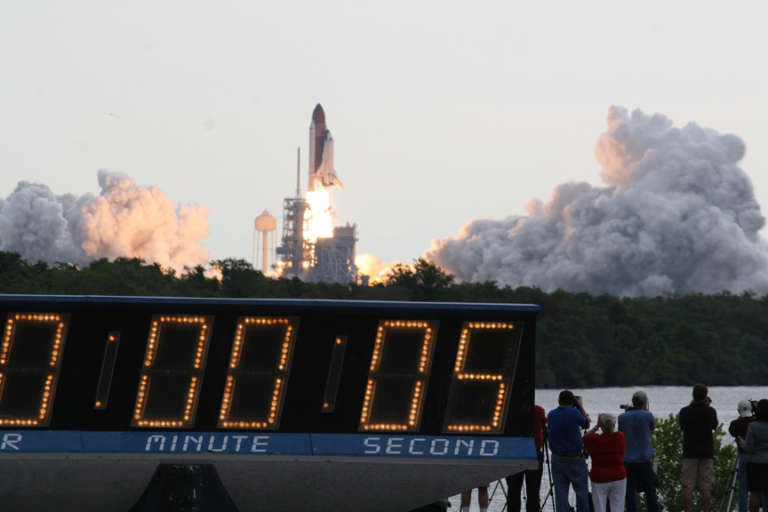Ken Kremer • Jun 15, 2011
Historic Final Flight of Space Shuttle Endeavour
After a 16 day journey of more than sixteen million miles, Space Shuttle Endeavour and her six man crew glided to a safe nighttime landing at 2:35 a.m. EDT on June 1 at NASA's Kennedy Space Center in Florida. I watched from close by the shuttle landing strip as the ghostly ship flew past, preceded by shocking twin sonic booms.
The STS-134 mission marked the end of Endeavour's space flight career. It was the penultimate flight of the shuttle program and the 25th and final one for the youngest orbiter in NASA's shuttle fleet. Altogether, Endeavour has logged 299 days in space, orbited Earth 4,671 times and traveled 122,883,151 miles.

Shuttle Commander Mark Kelly led the STS-134 mission. He was joined by Pilot Greg H. Johnson and Mission Specialists Mike Fincke, Drew Feustel, Greg Chamitoff and the European Space Agency's Roberto Vittori.
The primary goal of the highly productive flight was the delivery of the $2 Billion Alpha Magnetic Spectrometer (AMS) to the International Space Station. AMS is a state-of-the-art cosmic ray detector that seeks to unveil the invisible universe and search for evidence of dark matter, strange matter, and antimatter.
The $2 Billion Alpha Magnetic Spectrometer (AMS) may revolutionize our understanding of how the Universe was born and evolved over time. The AMS science instrument is sponsored by the United States and 15 other countries across the globe. Nobel Prize Winner Samuel Ting of MIT leads the international science project.
"What a great ending to this really wonderful mission," said Bill Gerstenmaier, associate administrator for Space Operation at a briefing for reporters "They're getting great data from their instrument on board the space station. It couldn't have gone any better for this mission."
The crew conducted the last 4 spacewalks that will ever by carried out by shuttle crew members during the space shuttle era. Simultaneously they completed the construction of the US portion of the ISS.
STS-134 was the 36th shuttle mission dedicated to ISS assembly and maintenance.
"You know, the space shuttle is an amazing vehicle, to fly through the atmosphere, hit it at Mach 25, steer through the atmosphere like an airplane, land on a runway, it is really, really an incredible ship," said Kelly.
"On behalf of my entire crew, I want to thank every person who's worked to get this mission going and every person who's worked on Endeavour. It's sad to see her land for the last time, but she really has a great legacy."
Endeavour blasted off at last on her historic final spaceflight on May 16 following a two week delay caused by a heater malfunction in the fuel line that powers the orbiters hydraulics. Endeavour lifted off from Pad 39 A at the Kennedy Space Center (KSC) at 8:56 a.m. EDT.

Overcast skies moved in over the pad in the last 30 minutes of the countdown and nearly derailed the launch again. I witnessed Endeavour's majestic launch from the KSC press site next to the world famous countdown clock.
Endeavour's three main engines roared to life six seconds before the twin Solid Rocket Boosters were ignited and pushed the shuttle off the pad atop a tremendous roar and brilliant flames shooting from Endeavour's tail. The rumbling thunder seemed much louder than normal, perhaps due to the cloud cover. Endeavour disappeared into the clouds at about T plus 25 seconds.
Nearly half a million people crowded into the Florida Space Coast to witness history first hand.
"This mission represents the power of teamwork, commitment and exploration," Commander Mark Kelly said shortly before liftoff. "It is in the DNA of our great country to reach for the stars and explore. We must not stop. To all the millions watching today including our spouses, children, family, and friends, we thank you for your support."
Endeavour was towed back into the Orbiter Processing Facility (OPF) after the landing where she will be cleaned and "safed" in preparation for her permanent retirement home and public display at the California Science Center in Los Angeles.
The stage is now set for the July 8 blastoff of STS-135, the very final flight of the 30 year long shuttle era.

Support our core enterprises
Your support powers our mission to explore worlds, find life, and defend Earth. You make all the difference when you make a gift. Give today!
Donate

 Explore Worlds
Explore Worlds Find Life
Find Life Defend Earth
Defend Earth

